
PROTOTYPE ARC LS
(Luxeon Star)
This is a long page with at least 53 images on it; dial-up users please allow for plenty of load time.
All your base are belong to us. 
Arc LS (Luxeon Star), retail $120 (see 09-18-02 update) (URL no longer valid)
Manufactured by Arc Flashlight, LLC
Last updated: 10-22-22
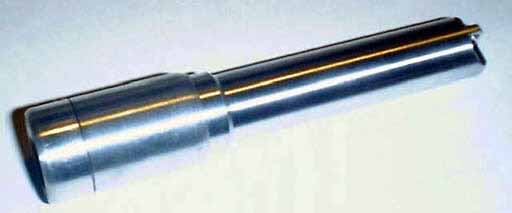

IMPORTANT! Effective 09-22-04, this product is no longer being made, but here is information on it anyway.
THE BARE METAL UNIT IS AN EARLY PROTOTYPE, AND IS IN AN UNFINISHED STATE OF MANUFACTURE.
UNTIL THE LS GOES INTO PRODUCTION, INFORMATION WILL BE LIMITED.
The Arc LS (Luxeon Star) is a true revolution and will represent the first major leap in flashlight technology since the white LED
was introduced in the mid 1990s. Instead of using ordinary 5mm LEDs, the Arc LS uses a single Luxeon Star Power Light Source,
a very bright white LED made by LumiLeds. See below for a bit more info.
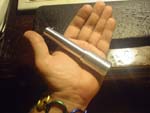
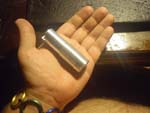
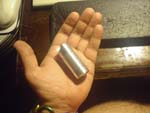
Sizes: (L) 2-AA. (C) 1-AA (R) 1 lithium CR123

The Arc LS will come in several configurations; all of them related to the type of battery you want to use in it.
The prototype arrived with a body for 2 "AA" cells, a body for 1 "AA" cell, and a body for 1 CR123 lithium camera battery.
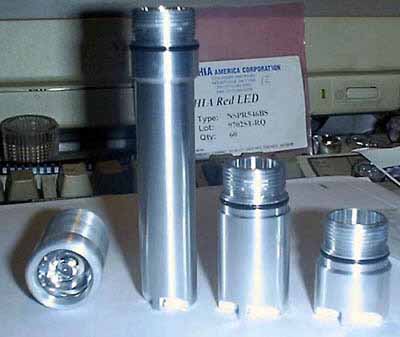
From left to right:
Arc LS power head
2- AA battery holder
1- AA battery holder
1- lithium CR123 battery holder
Pick your poison (type of battery & pack) and just use it.
To turn this photonic cannon on, give the head a clockwise twist; rotate it the other way to shut it off.
It's probably not a good idea to stare into the Arc LS when it is on; as the light output is very high and it is remotely possible to injure yourself
as with any of the modern nitride-type LEDs.

To change either the batteries or the battery holder on the LS, unscrew the head until it comes off.
Then choose the battery style you wish to use.
For all battery types, drop the battery / batteries into the holder so the button-end faces up toward you.
Then screw the holder onto the head until the light comes on; then back it down half a turn or so.
A series of battery drain tests will be done over the next week or two, so please stay tuned.
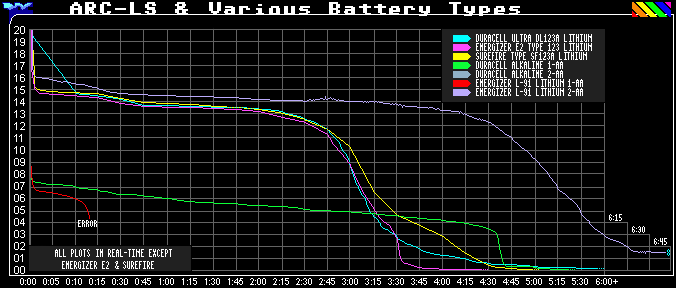

Battery test results - preliminary and for prototype only
Current usage measures 119.80mA (1x AA cell) and 410mA (2x AA cells).
The 1 cell measurement was made on my DMM's 200mA scale; the two cell measurement was made on the instruments 10A scale.

So far, the Arc LS looks like it will turn out to be one of the roughest, toughest flashlights money can buy.
The battery holders are made from one-piece aluminum billets, and they're really thick and beefy. They are sealed by an O-ring
for water resistance, and provide a snug, secure fit to the head with no looseness or wobbling.
The threads are lubricated with silicone grease, providing for an exceptionally smooth rotary action.
The power head is constructed equally well. A compressed foam ring is present on the bottom of the PCB to prevent that annoying rattle from
a loose battery while the light is not in use.

The CR123 battery holder and the Arc LS power head.
Notice the attention to detail even in this early prototype stage.
When it comes out, the Arc LS will have various refinements like a knurled grip and other additions.
For the purposes of these tests, the final finishing steps were not necessary and won't affect the actual performance of the light, so they were omitted.
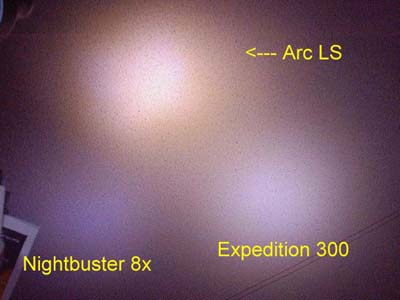
Comparing the prototype Arc LS (1 LED) with the popular
Expedition 300 (7 LEDs) and the Nightbuster 8X (8 LEDs).
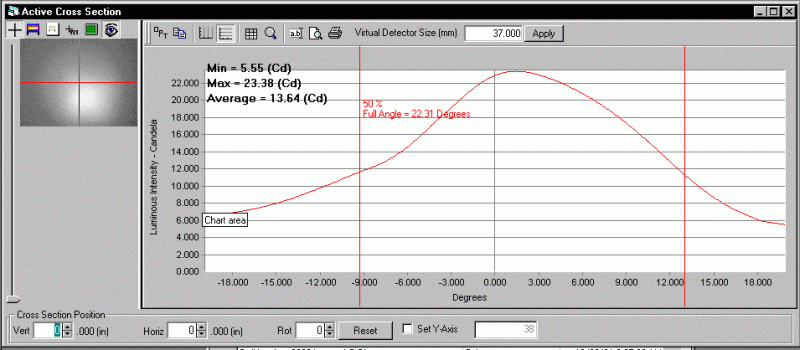
Beam cross-sectional analysis.
Image made using the ProMetric System by Radiant Imaging.
As you can see, the beam is brighter than multiple LED lights - and good ones at that.
Actual brightness measurements will not be posted yet, as this could also change when the LS goes into production. But suffice it to say it
will be a bright S.O.B.
(Update: Here are some preliminary measurements:)
2 Energizer Lithium AA: 80,500mcd
2 Right-Aid alkaline AA: 73,600mcd
1 Energizer Lithium AA: 56,100mcd
1 Right-Aid alkaline AA: 50,100mcd
1 Surefire CR123 photo: 71,000mcd
The CR123 configuration will be run-time tested first, using three different brands (Energizer e2, Duracell Ultra, and Surefire).

The heart of the Arc LS is the Luxeon Star Power Light Source, a new kind of LED made by LumiLeds.
The model used in the Arc is the one that looks like half a pop can in this picture, the one with the black thing & the lens.
These LEDs are rated to emit between 18 and 23 lumens, which, for the very first time in the history of the LED, is
more than some of the incandescent bulbs & incandescent flashlights on the market.
The light quality of the Arc LS is higher than other common LED sources. The color temperature is lower, giving the light
a whiter, warmer appearance unlike the distinctly bluish color found in all other white LED flashlights. Those who tend to shun these bluish
white lights might feel more comfortable with the Arc, as the color is closer to "overcast daylight" than the others.
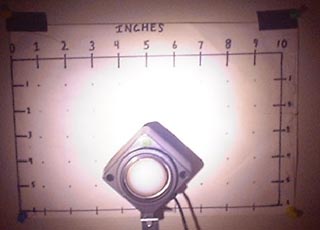
Typical beam configuration a little over a foot from the target.

1: Target (a toliet & fan by a door) in normal illumination.
2: 2 lithium AA
3: 2 alkaline AA
4: 1 123
5: 1 lithium AA
6: 1 alkaline AA
Pictures taken November 05, 2001, found again on May 31, 2003 on CPF.
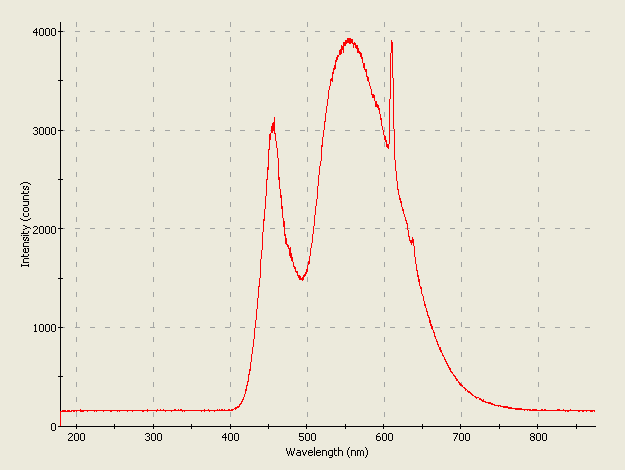
Spectrographic analysis of the white Luxeon I LED in this flashlight.

Same as above; new spectrometer software & settings were used.
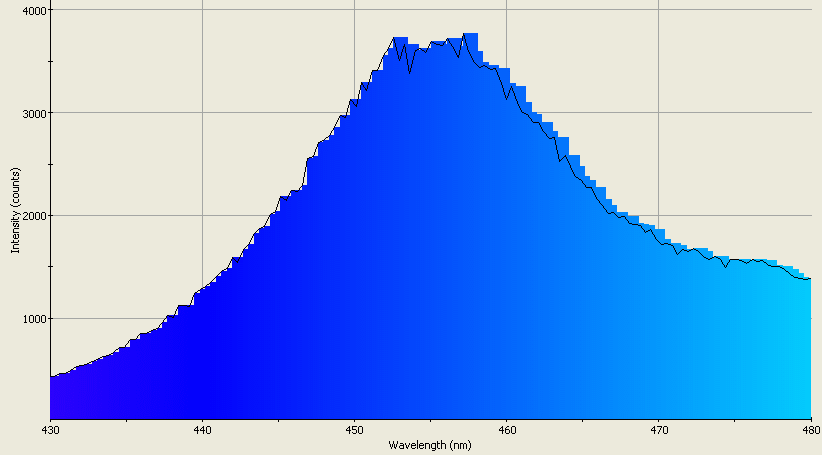
White Luxeon I LED in the prototype unit; spectrometer's response narrowed to a band between 430nm and 480nm to pinpoint LED's native emission peak (well, two peaks actually) of 452.550nm and 457.220nm.
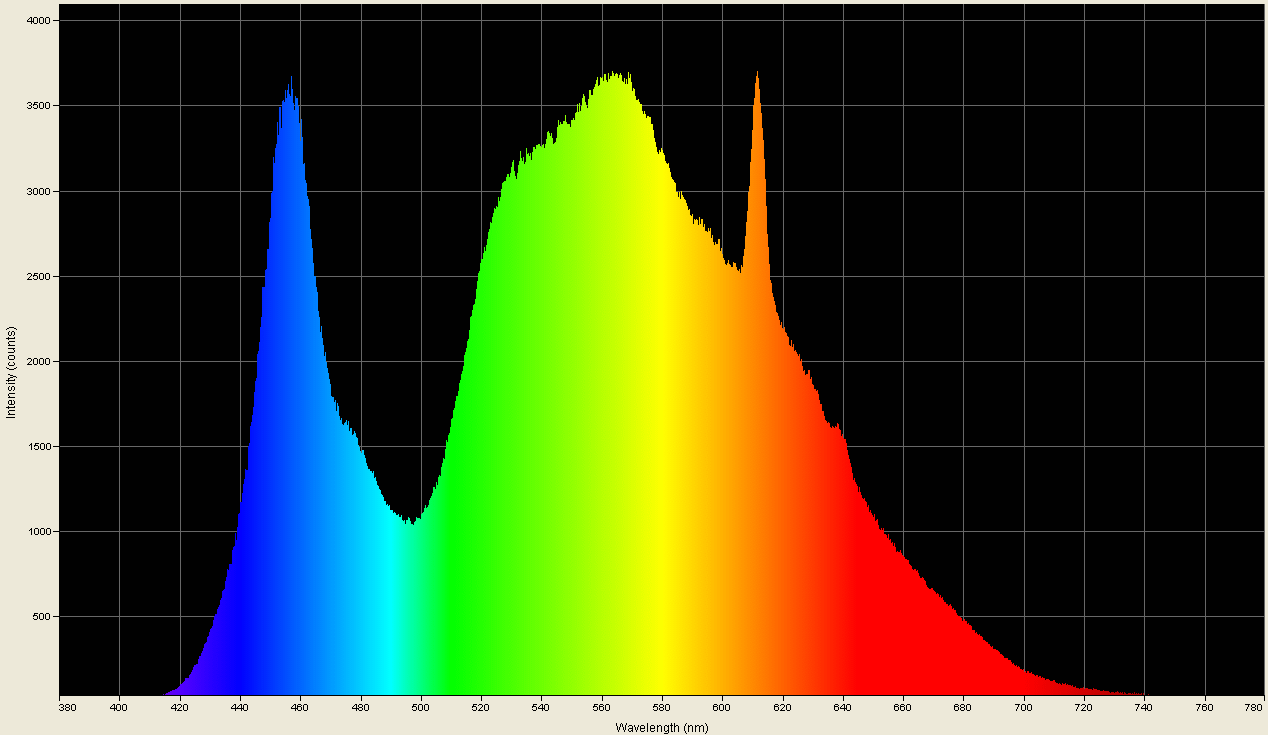
Same as above; yet newer spectrometer software & settings were used.
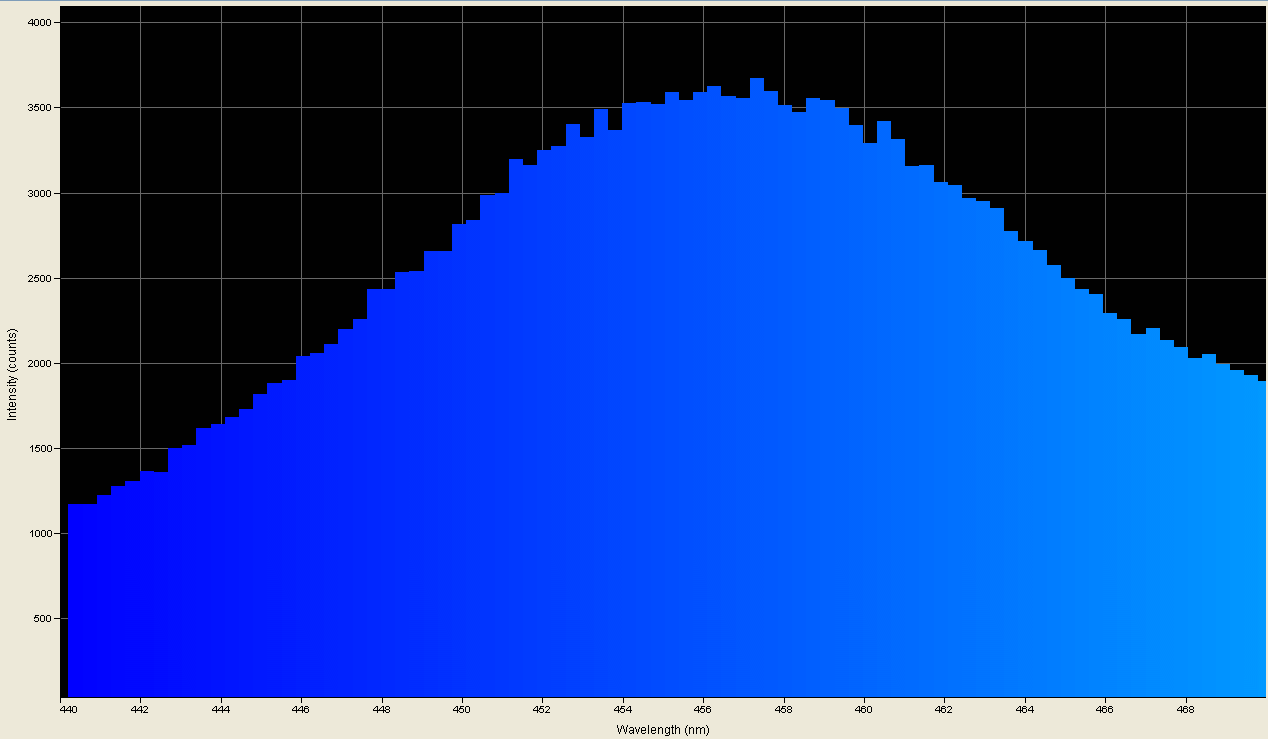
White Luxeon I LED in the prototype unit; spectrometer's response narrowed to a band between 440nm and 470nm to pinpoint LED's native emission peak of 457.170nm
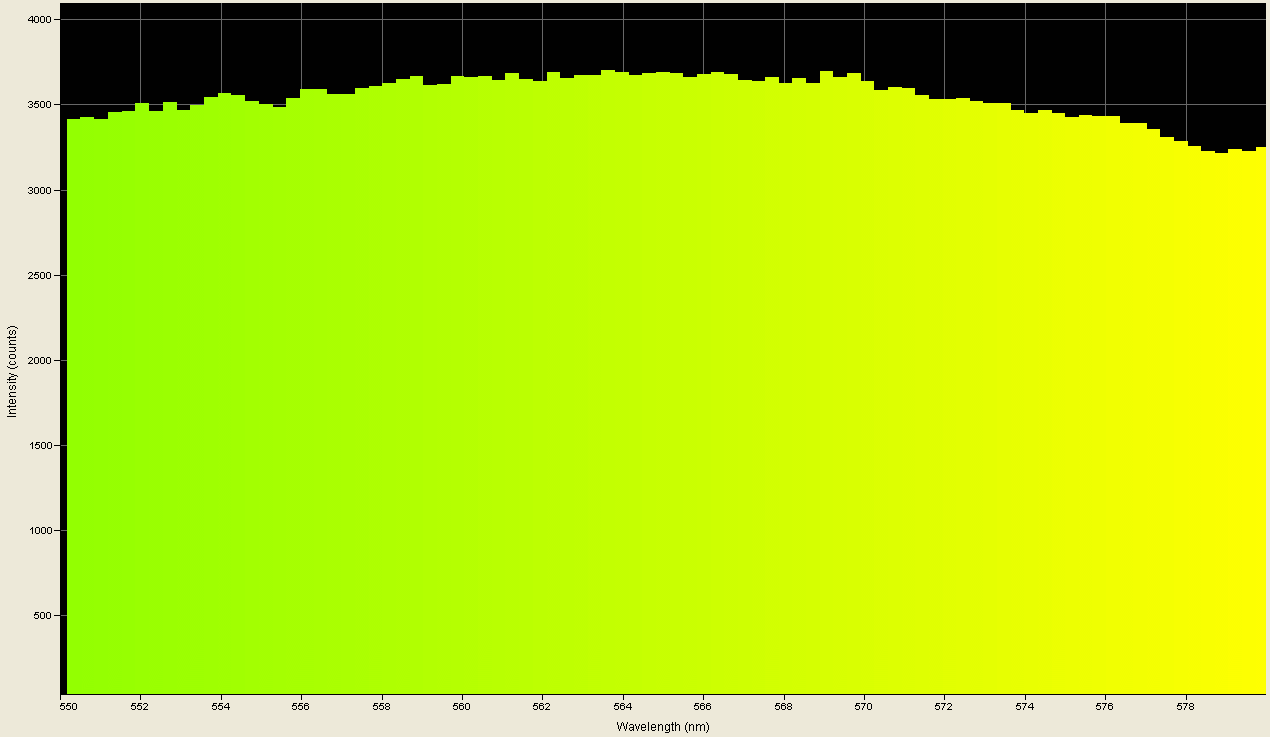
White Luxeon I LED in the prototype unit; spectrometer's response narrowed to a band between 550nm and 570nm to pinpoint LED's phosphor emission peak of 563.480nm
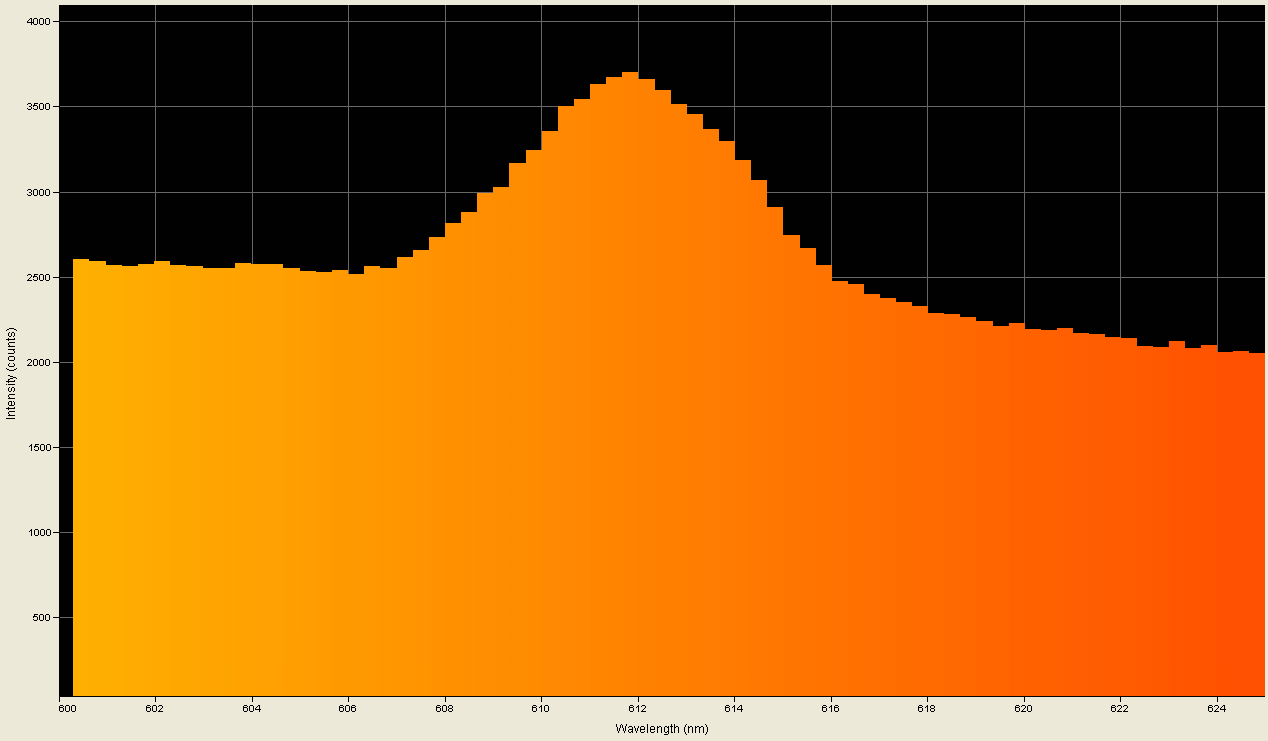
White Luxeon I LED in the prototype unit; spectrometer's response narrowed to a band between 600nm and 625nm to pinpoint a curious phosphor spike at 611.690nm
The raw spectrometer data (tab-delimited that can be loaded into Excel) is at alsproto.txt
USB2000 Spectrometer graciously donated by P.L.
TEST NOTES:
THE BARE METAL UNIT IS AN EARLY PROTOTYPE, AND IS IN AN UNFINISHED STATE OF MANUFACTURE.
UNTIL THE LS GOES INTO PRODUCTION, INFORMATION WILL BE LIMITED.
Here are some improvements that I'm either suggesting, or that may already be on the boards:
- Beam alignment should be improved. When the light is rolled on a table or floor, the beam traces a circle instead of staying centered.
- Beam quality should be improved (and as far as I'm aware of, already is being worked on).
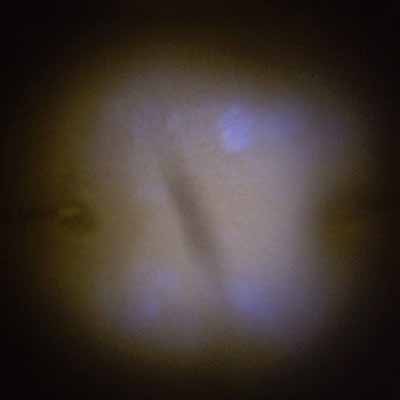
This is a look down the barrel with the LS running at somewhere between 0.001% and 0.0001% power.
This image of the LED chip through the Luxeon Star's built-in optics
remarkably mirrors the actual beam that comes out of the unit,
except that the dark line across the middle is absent.
The blue areas do show up in the actual beam though, and in the same positions.
- The threaded tailcap on the 2-AA body should be sealed. In tests, when hung from a keyring, it tended to unscrew itself over the course of several hours.
The manufacturer is already planning on sealing this, but some early beta testers may not be aware of it.
- Despite the annular foam ring on the bottom of the PCB, battery rattle is still present.
- Add protection to the Luxeon Star LED's lens, such as a disc of Pyrex or other hard, scratch-resistant (or at least easily replaceable) material. If the relatively soft lens of the LED becomes
marred or scratched (through accident or just by carrying the Arc in your pocket), it is not easily replaceable - and not replaceable at all by the end user.
- During the manufacturing process, handle the Luxeon Star LED and its lens with lens-quality gloves. The prototype version shows a large number
of scuffs and/or fingerprints on the underside of the lens, where they cannot be cleaned away.
- The light easily rolls away and vanishes because there is no anti-roll fin or other structure.
And here are some of the things I like about the LS.
- First and foremost, it's BRIGHT. Using the 2-AA pack, the prototype exceeded 80,500mcd even though its LED may be underdriven.
This is like 14 ordinary 5,600mcd Nichia white LEDs driven to factory specs.
- The light has a sturdy, substantial feel to it. The 2-AA module feels like a real flashlight in the hand, and should appease those
who like the feel of a Mini-Maglite style flashlight.
- The 1-AA and lithium modules are considerably smaller, and can make the Arc LS a pocket-sized light. When used with the single
CR123 battery, the light actually comes close to being truly keychain-sized. It's a bit big around the waist, but it's not at all heavy
and most people should easily adapt to having it on their keys.
- The light is extremely strong and virtually indestructible, and can probably be used as an emergency hammer, or be used to destroy that damn urinator that always splashes your
pants leg when you flush it.
- Even in this early stage, I feel like something's missing when I don't leave home with it.
- The light can be stood on-end and used as an "electronic candle", illuminating a whole room from its beam reflecting off the ceiling.
UPDATE 06-15-02: The first production Arc-LS is being made; however there is a substantial backlog while the bugs are worked out of the manufacturing process. A limited number of "factory seconds" come out of the process; the price is $70 when available.
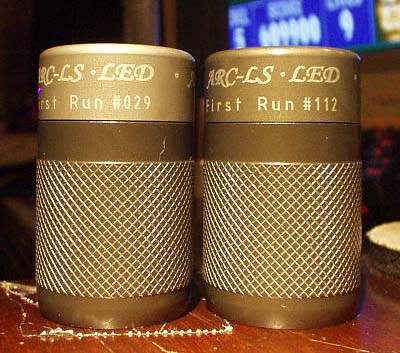
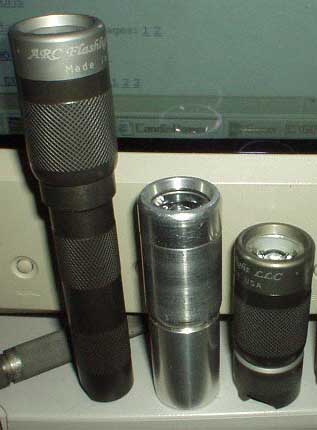
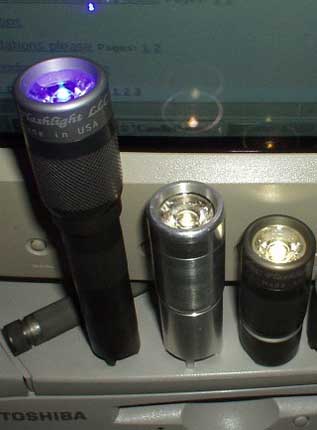
UPDATE 09-18-02:
Although I have not yet tested a "First" and therefore cannot yet perform a proper review of this product, they are now available at
The LED Light. The configuration being sold here is the "Factory First" (prime version, not a second) with 1x CR123 tube or a 2x AA tube. Expect the Firsts to have a more round beam with little to no blotchiness to it, unlike the photograph shown above. Price is $120.
201,000mcd on Sanyo CR123A lithium battery (White)
252,000mcd on Sanyo CR123A lithium battery (Cyan loaner unit)
UPDATE 04-06-03:
CPF member Cyclops942 (Kris C.) loaned me his cyan Arc-LS just before I wound up in the hospital for brain surgery last September, and I promptly forgot about it. Here now are the pictures for your enjoyment.

Kris's Arc-LS against the test target at 12".
This one measured 252,000mcd at 12", and it has a nice beam, though slightly more greenish than I expected from a cyan (blue-green) LED.

Kris's Arc-LS with 123 battery pack on a table.
Looks like he got serial number 788.
UPDATE 09-06-04:
The Arc Company of Tempe, Arizona was started in May of 2001 by Peter Gransee.
The original 'First Run's or 'Rev1's
First announced in June 2001.
This was the first flashlight on the market using a Luxeon Star Low Dome LED.
Also called 'LS1 rev1'.

These have the laser engraving "First Run" and have a 2 piece body (bezel and body secured with Loctite).
Fatter than the current "one piece body". 123 tailcap is fat too.
Came with 123, 1AA, 2AA 'twisty' battery packs. The 1AA was slimmed down later.

ver 0.9
First shipped in December of 2001. Voltage regulated.
Low Dome Luxeon
Retainer optimized for the AA pack.
ARC offered an upgrade to Ver1.0 or a 30$ coupon.
Available in 6 colors White, Cyan, Green, Blue, Red, Amber (and ??2 Orangish Red and Royal Blue ???)

[CCW from front row left, orange/red, blue, red, cyan, amber, green, white]
ver 1.0
March 2002
Redesigned battery retainer
Raised knurling plain
New threads
Improved manufacturing standards
Retainer optimized for AA and 123
New NX05 optics
"Factory Seconds" are announced March 2002
ver 1.1 ?? 2002
123 guide chamfer added to solve 123 crushing problem
ver 1.2 Jul 2002
Retainer optimized for 123 cell
Cleaner HA
Rev 1s have a flat gold positive contact. Later versions have a raised 'button' contact.
LS1 Rev 2 and LS2 Announced August 2002
The models engraved "LS1" are low dome, "LS2" is high dome. The LS2 was the first flashlight on the market to use the Luxeon Star High Dome LED.

Low Dome Luxeon (LS1 rev2)
High Dome Luxeon(LS2)
New one piece housing
Smaller diameter than Rev1
NX05 optics protected behind AR coated lens
New efficient heat sink
Gold raised button contact
1AA bat pack discontinued
1.4v cutoff
New PCB circuit by Dat2Zip
Current regulated
Higher output
Thermally protected
Waterproof
Pricing LS1 Rev2 $120
ver2.1 Flex washer
LS3 (5W 2x123) announced
First flashlight on the market to use the 5 Watt Luxeon Star driven at 2 Watts. Rev2 technology. 2x123 battery. Waterproof.
Kroll clickie announced
Rev 1/2 Hybrids
Announced Sep 2002 Shipped Sep 2002
These look exactly like "First Runs" or Rev1s, but have a Rev 2 heatsink and circuit(Dat2Zip). Lowdome Luxeon.
The only way to tell them apart is to look at the positive battery contact. Hybrids will have a raised button contact, Rev1s will have a flat contact.

There were 2 types of Hybrids made, a 400mA version (actually set for 330mA, mistakenly reported as 400mA), and a 500mA version (actually 400mA, mistakenly reported as 500mA). The 500 version resulted from a wrong resistor being accidentaly installed and was not intended.
The 400s have a green PCB with raised gold positive contact. The 500s have a brown PCB with raised gold positive contact.
LS2 Seconds (SLS2) start shipping Dec 2002
LS1 rev1 Announced to be discontinued Dec 2002
Twisty 123 (P-123) changed to Kroll type (TSP-123)on all models late 2002
LS3 Discontinuation announced before product ships
Small number to be offered in Jan 2003
Lineup Renamed and upgraded to ver 2.1
LS1 rev2 renamed LSL (low dome)
2 grades
LSL aka LSL-S : standard
Low Dome LED with M-N Flux and 3-4 Tint. $120 Retail
LSL-P : premium
Premium version of LSL with P-Q Flux and 3-4 Tint for a brighter beam. $150 Retail
LS2 renamed LSH (high dome)
2 grades
LSH aka LSH-S : standard
High Dome LED with M-N Flux and 3-4 Tint for a more focused and whiter beam. $130 Retail
LSH-P : premium
Premium version of LSH with P-Q Flux and 3-4 Tint for a brighter beam. $160 Retail
Dimensions on all LSL & LSH variations are 3.2" long x .95" diameter and 2.2 ounces with TSP123.
Note: “Second” quality versions (w/o warranty, sold at a discount) are sometimes described by an “S” before the model (ie: Arc SLS)

LSHF-P Announced June 2003. Becomes available in Fall 2003.
Special Edition Arc LSH-P w/Tight Focus Beam High Dome Luxeon LED. Premium built with P or Q flux Luxeon only. Includes TSP-123. Independently tested to produce 22-26 Lumens regulated. This Special Edition design appears the same as the top of the line LSH-P on the outside, but inside uses the "Fraen Low Profile" optic to produce a more tightly focused beam but with less spill. The difference is clearly visible, producing 745 lux vs 614 lux at 3 feet. $160 Retail
The earlier batch had the same engraving as a normal LSH-P, later units had LSHF-P laser engraved.
LS3 Approx 3 dozen units offered Sep 2003

Arc4 (LS4) start shipping Feb 2004
Arc4 Forensic Kit offered
IMPORTANT: Photographs and chronology text were used with permission.
UPDATE 10-07-04:

Photograph of the Arc-LS Prototype with the CR123A battery pack on it.
I know, it has some markings from use - but that's what Arcs were meant for anyway, right?
NOTE: This information is not to be taken as a true review. The tested unit is a prototype, and the information is for beta-testing purposes only.
It is provided to you only as a courtesy, and should be taken with large amounts of crystallized sodium chloride.
UPDATE 05-26-06:
I was not able to find my custom-made Arc LS; outfitted with a royal blue Luxeon III driven at 667mA because my former downstairs housemate has apparently run off with it.
That's the reason for the " *" icon next to the listing for this flashlight on my website's main menu.
*" icon next to the listing for this flashlight on my website's main menu.
UPDATE 06-15-06:
I was offered a royal blue Arc LS a few days ago for just $100.00 by a kind CPFer, so of course I took the bate and purchased it. It arrived this morning!!!




Photograph of the flashlight itself, so you know I really have it.
Labelled as First Run #165.
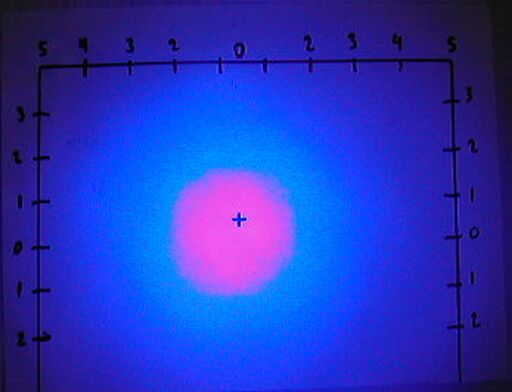
Photograph of its beam 12" from the test target.
Measures 80,700mcd on a Meterman LM631 light meter.
This value may be a bit low because this wavelength is right on the edge of my meter's perception. Violet splotch in the center does not exist in real life; digital cameras have a tough time with these wavelengths.
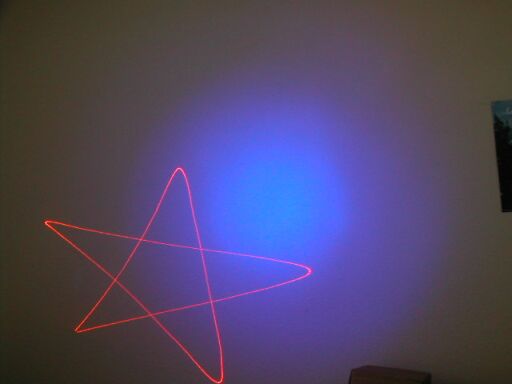
Photograph of its beam on a wall at ~10 feet.
That red star thing on the wall is from an American DJ Laser Widow.
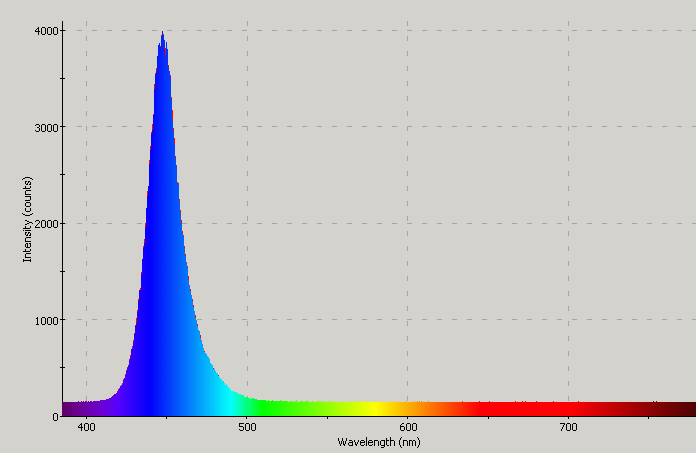
Spectrographic analysis of the LED in this flashlight.
USB2000 spectrometer graciously donated by P.L.
UPDATE 02-24-07:

Beam cross-sectional analysis (royal blue LED).
Image made using the ProMetric System by Radiant Imaging.
UPDATE 05-17-09:

Spectrographic analysis of the phosphor cap of the white LED in the prototype Arc LS when irradiated with a Handheld ~412nm Blu-ray (Violet-Emitting) Laser.
UPDATE 05-22-09:
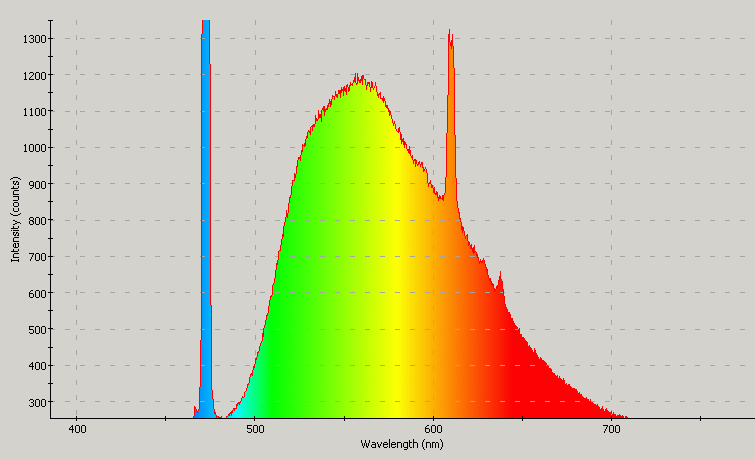
Spectrographic analysis of the phosphor cap of the white LED in the prototype Arc LS when irradiated with a 473nm Rechargeable Blue Laser.
UPDATE 08-12-09:
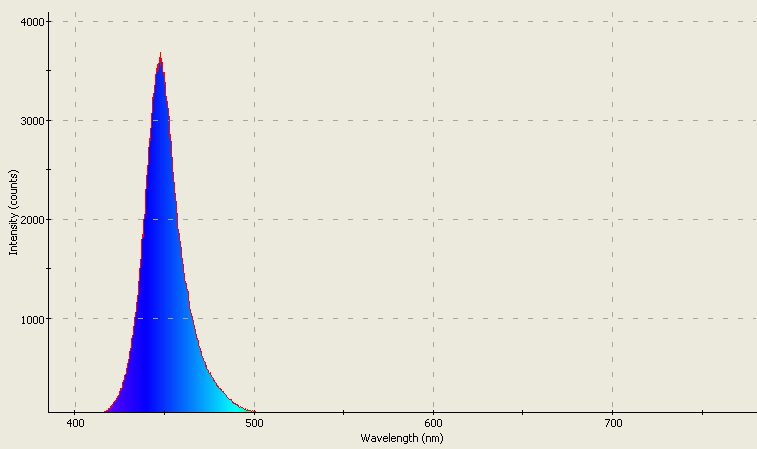
Spectrographic analysis of the royal blue LED in the royal blue LED version of this flashlight; newer spectrometer software & settings used.
USB2000 spectrometer graciously donated by P.L.
UPDATE 11-13-18:
I've been using this flashlight as a headlight on my electric wheelchair.
Works quite well thankyouverymuch!!!
UPDATE 10-25-19:
I had a scary last several weeks regarding this flashlight; it mysteriously turned up missing and I feared the worst -- that some dillhole kyped it! 
I even had a suspect in mind, but without the slightest shred of evidence I was in no position to accuse him or even question him about the flashlight. But it inexplicably turned up -- and in a place I had already searched -- under the night table!!!

As far as I'm able to determine, it got nocked off the night table when I fell out of bed several weeks ago, and rolled under the night table -- coming to rest near its NE corner. That's where I found it early yesterday afternoon when I started another search for it.
Phew!!! I'm so glad that I found it, because it's an extremely important part of flashlight history!!! 
Manufacturer no longer exists (or at least no longer has a web presence) so I've removed the links to Arc Flashlight LLC and suffixed the, " " icon to its listings on my website.
" icon to its listings on my website.
UPDATE 08-13-20:
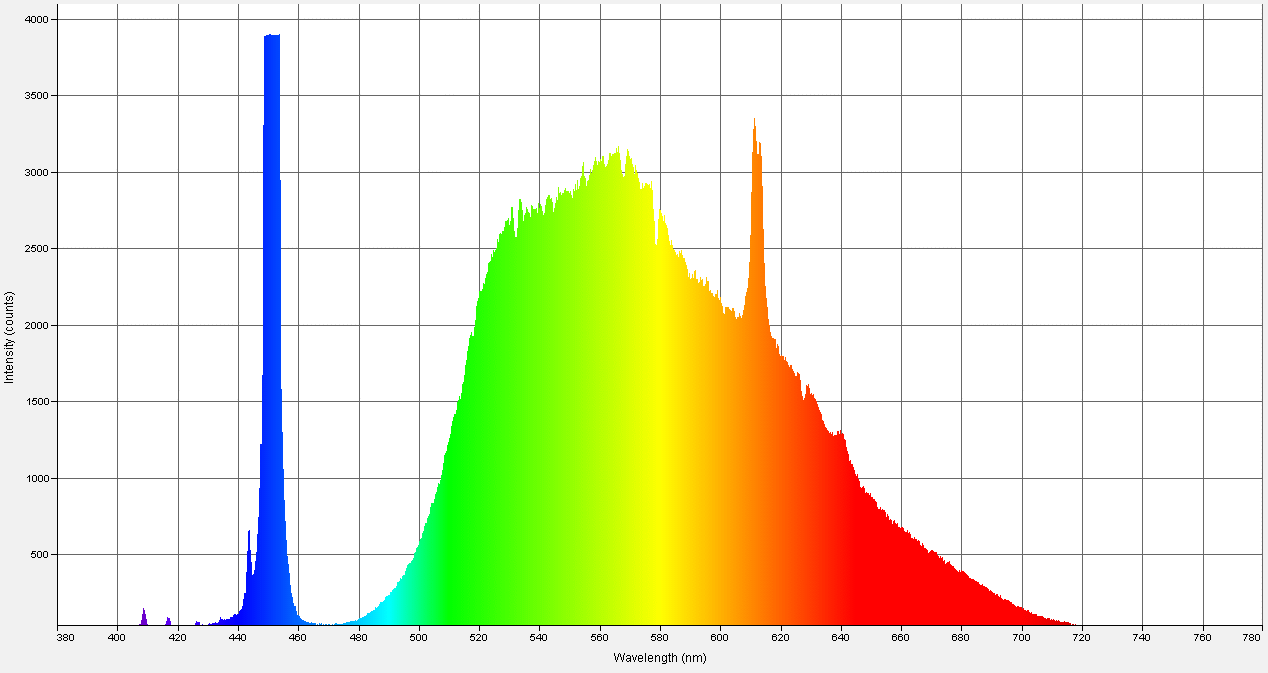
Spectrographic analysis of the LED in this flashlight when irradiated with the Blue-Emitting Laser Pen 5mW 445nm 450nm.
The raw spectrometer data (tab-delimited that can be loaded into Excel) is at als450.txt
UPDATE 10-22-22:
I have the sad duty to report that I no longer have this (or anything else for that matter); I fell prey to a stroke in March 2022 and a paranoid relative disposed of everything that I owned on 05-15-22 while I was still in the nursing home. :-(

MANUFACTURER: Arc Flashlight, LLC
PRODUCT TYPE: The world's FIRST Luxeon Star LED flashlight
LAMP TYPE: 1W white Luxeon Star LED
No. OF LAMPS: 1
BEAM TYPE: Medium spot w/soft corona
SWITCH TYPE: Twist bezel on/off
CASE MATERIAL: Aluminum
BEZEL: Aluminum; LED protected by its plastic optic
BATTERY: 2x AA cells, 1x AA cell, or 1x CR123A cell
CURRENT CONSUMPTION: 119.80mA (1x AA cell), 410mA (2x AA cells)
WATER- AND URANATION-RESISTANT: Yes
SUBMERSIBLE: Unknown, but probably ¡¡¡HOZAY FELECIANO UTILIZANDO UNA ESCUPIDERA NO!!!
ACCESSORIES: 1x AA battery tube, 1x CR123A battery tube
SIZE: 128mm L (2x AA battery tube) x 25.10mm Dia.
WEIGHT: 57.60g (2.030 oz.) empty, 100.70g (3.55 oz.) w/ 2 AA cells
COUNTRY OF MANUFACTURE: USA
WARRANTY: Probably none (this ***IS*** a prototype!)

ARC LS (Luxeon Star) *
Do you manufacture or sell an LED flashlight, task light, utility light, or module of some kind?
Want to see it tested by a real person, under real working conditions? Do you then want to see how your light did? If you have a sample available for this type of
real-world, real-time testing, please contact me at bdf1111@yahoo.com/.
Please visit this web page for contact information.
Unsolicited flashlights, LEDs, and other products appearing in the mail are welcome, and it will automatically be assumed that you sent it in order to have it tested and evaluated for this site.
Be sure to include contact info or your company website's URL so visitors here will know where to purchase your product.
This page is a frame from a website.
If you arrived on this page through an outside link,you can get the "full meal deal" by clicking here.










































 *" icon next to the listing for this flashlight on my website's main menu.
*" icon next to the listing for this flashlight on my website's main menu.














